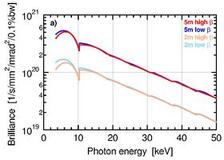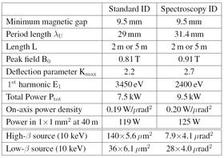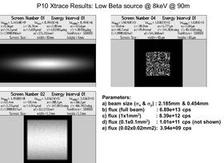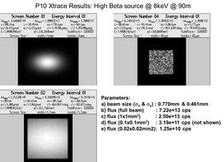P10 uses a 5m long U29 undulator device. The figure (Fig. 4.1.1 of the PETRA III TDR) shows the calculated brilliance for the PETRA III standard undulator for low and high beta source configurations at 2m or 5m length.
At the beginning of 2020 the U29 undulator was replaced by an U32 undulator. The corresponding higher magnet period length shifts the undulator harmonics to lower energies. The advantage of the new undulator is that no energy gap between 1st and 3rd undulator harmonic is expected. However, it comes at the price of a reduced overall brightness of about 10%. The actual minimum gap of the new undulator is ~9.7mm.
Flux measurements at P10:
P10 undertook an attempt to determine the delivered photon flux in December 2010. At this time the beamline was in a high beta configuration and PETRA III was running in a reduced current mode at 55mA. The measurements used an undulator gap of 16.525 and the monochromator was set to 8.05keV. The mirrors were used to suppress the higher harmonics with an incident angle of ~0.158 degree. A calibrated PIN diode (H.-P. Liermann, P02, calibrated at APS) was used to measure the intensity. The measurements are in good agreement with the XTRACE calculations (~10% deviation).
Coherent flux estimate for P10 (8keV, Si(111), 90m):
These are estimates of the expected coherent flux or (in other words) the intensity behind a slit of a size, which matches the transverse coherence area. To make numbers comparable, here is the formula used for the transverse coherence length in these estimates:
xit = 1/(2 x √π) x R/(2.35 x sigma) x lambda
'lambda' is the X-ray wavelength, 'R' is the distance between source and slit and 'sigma' is the 1-sigma source size of PETRA III (see last two rows of table 4.1.1 above). Sometimes the coherence length is estimated using different prefactors, normally resulting in larger values.
At 90m from the source and at 8keV photon energy, the transverse coherence length is 277 µm in the vertical direction and 46 µm in the horizontal direction in low beta configuration. The predicted intensity behind a slit of this size is 1.3 x 1011 cps.









